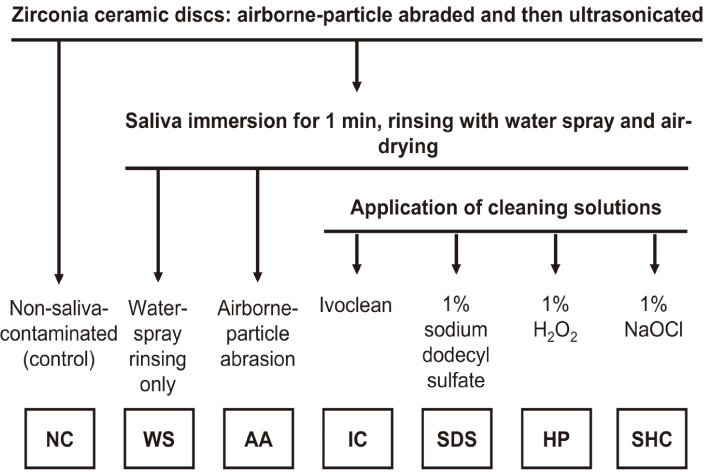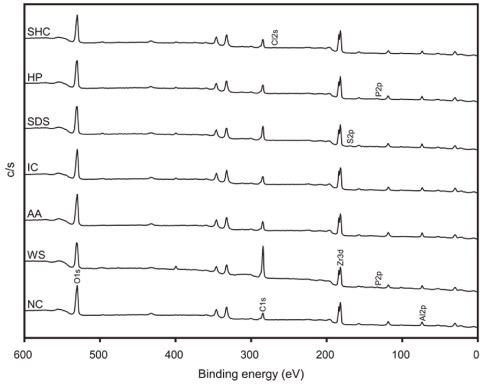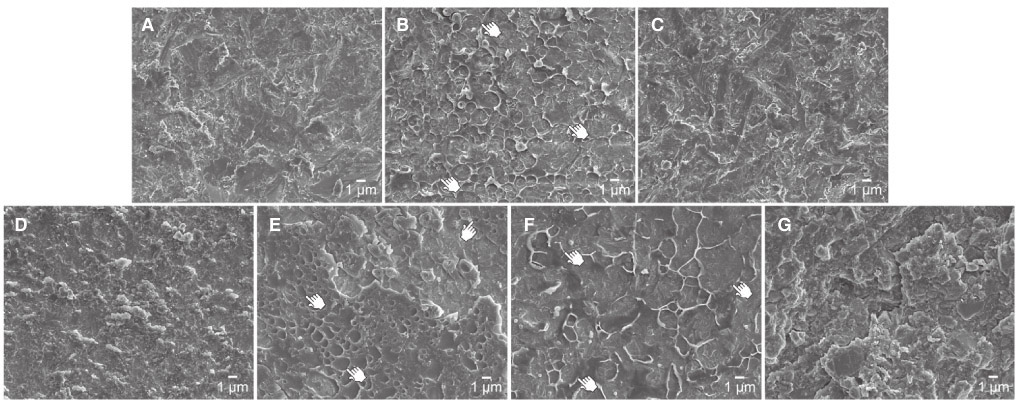J Adv Prosthodont.
2015 Apr;7(2):85-92. 10.4047/jap.2015.7.2.85.
Efficacy of various cleaning solutions on saliva-contaminated zirconia for improved resin bonding
- Affiliations
-
- 1Department of Medical & Biological Engineering, Graduate School, Kyungpook National University, Daegu, Republic of Korea.
- 2Korea Textile Development Institute, Daegu, Republic of Korea.
- 3Faculty of Health Science, Daegu Haany University, Gyeongsan, Republic of Korea.
- 4Department of Conservative Dentistry, School of Dentistry, Kyungpook National University, Daegu, Republic of Korea.
- 5Department of Dental Biomaterials, School of Dentistry, Kyungpook National University, Daegu, Republic of Korea. tykwon@knu.ac.kr
- KMID: 2118237
- DOI: http://doi.org/10.4047/jap.2015.7.2.85
Abstract
- PURPOSE
This study aimed to investigate the efficacy of cleaning solutions on saliva-contaminated zirconia in comparison to air-abrasion in terms of resin bonding.
MATERIALS AND METHODS
For saliva-contaminated airabraded zirconia, seven cleaning methods)-no contamination (NC), water-spray rinsing (WS), additional airabrasion (AA), and cleaning with four solutions (Ivoclean [IC]; 1.0 wt% sodium dodecyl sulfate [SDS], 1.0 wt% hydrogen peroxide [HP], and 1.0 wt% sodium hypochlorite [SHC])-were tested. The zirconia surfaces for each group were characterized using various analytical techniques. Three bonded resin (Panavia F 2.0) cylinders (bonding area: 4.5 mm2) were made on one zirconia disk specimen using the Ultradent jig method [four disks (12 cylinders)/group; a total of 28 disks]. After 5,000 thermocycling, all specimens were subjected to a shear bond strength test with a crosshead speed of 1.0 mm/minute. The fractured surfaces were observed using an optical and scanning electron microscope (SEM).
RESULTS
Contact angle measurements showed that groups NC, AA, IC, and SHC had hydrophilic surfaces. The X-ray photoelectron spectroscopy (XPS) analysis showed similar elemental distributions between group AA and groups IC and SHC. Groups IC and SHC showed statistically similar bond strengths to groups NC and AA (P>.05), but not groups SDS and HP (P<.05). For groups WS, SDS, and HP, blister-like bubble formations were observed on the surfaces under SEM.
CONCLUSION
Within the limitations of this in vitro study, some of the cleaning solutions (IC or SHC) were effective in removing saliva contamination and enhancing the resin bond strength.
Keyword
MeSH Terms
Figure
Reference
-
1. Yang B, Scharnberg M, Wolfart S, Quaas AC, Ludwig K, Adelung R, Kern M. Influence of contamination on bonding to zirconia ceramic. J Biomed Mater Res B Appl Biomater. 2007; 81:283–290.2. Kim MJ, Kim YK, Kim KH, Kwon TY. Shear bond strengths of various luting cements to zirconia ceramic: surface chemical aspects. J Dent. 2011; 39:795–803.3. Wegner SM, Kern M. Long-term resin bond strength to zirconia ceramic. J Adhes Dent. 2000; 2:139–147.4. Quaas AC, Yang B, Kern M. Panavia F 2.0 bonding to contaminated zirconia ceramic after different cleaning procedures. Dent Mater. 2007; 23:506–512.5. Yang B, Lange-Jansen HC, Scharnberg M, Wolfart S, Ludwig K, Adelung R, Kern M. Influence of saliva contamination on zirconia ceramic bonding. Dent Mater. 2008; 24:508–513.6. Yang B, Wolfart S, Scharnberg M, Ludwig K, Adelung R, Kern M. Influence of contamination on zirconia ceramic bonding. J Dent Res. 2007; 86:749–753.7. Phark JH, Duarte S Jr, Kahn H, Blatz MB, Sadan A. Influence of contamination and cleaning on bond strength to modified zirconia. Dent Mater. 2009; 25:1541–1550.8. Boulange-Petermann L, Joud JC, Baroux B. Wettability parameters controlling the surface cleanability of stainless steel. In : Mittal KL, editor. Contact angle, wettability and adhesion. Leiden: VSP;2008. p. 139–151.9. Kim YK, Son JS, Kim KH, Kwon TY. Influence of surface energy parameters of dental self-adhesive resin cements on bond strength to dentin. J Adhesion Sci Technol. 2013; 27:1778–1789.10. Kim YK, Min BK, Son JS, Kim KH, Kwon TY. Influence of different drying methods on microtensile bond strength of self-adhesive resin cements to dentin. Acta Odontol Scand. 2014; 72:954–962.11. Takimoto M, Ishii R, Iino M, Shimizu Y, Tsujimoto A, Takamizawa T, Ando S, Miyazaki M. Influence of temporary cement contamination on the surface free energy and dentine bond strength of self-adhesive cements. J Dent. 2012; 40:131–138.12. Chibowski E, Hołysz L, Terpilowski K, Jurak M. Investigation of super-hydrophobic effect of PMMA layers with different fillers deposited on glass support. Colloids Surf A: Physicochem Eng Asp. 2006; 291:181–190.13. Hołysz L, Mirosław M, Terpiłowski K, Szcześ A. Influence of relative humidity on the wettability of silicon wafer surfaces. Ann UMCS Chem. 2008; 63:223–239.14. Phark JH, Duarte S Jr, Blatz M, Sadan A. An in vitro evaluation of the long-term resin bond to a new densely sintered high-purity zirconium-oxide ceramic surface. J Prosthet Dent. 2009; 101:29–38.15. Hagge MS, Lindemuth JS. Shear bond strength of an autopolymerizing core buildup composite bonded to dentin with 9 dentin adhesive systems. J Prosthet Dent. 2001; 86:620–623.16. Yun JY, Ha SR, Lee JB, Kim SH. Effect of sandblasting and various metal primers on the shear bond strength of resin cement to Y-TZP ceramic. Dent Mater. 2010; 26:650–658.17. Sattabanasuk V, Vachiramon V, Qian F, Armstrong SR. Resin-dentin bond strength as related to different surface preparation methods. J Dent. 2007; 35:467–475.18. McClean MD, Rinehart RD, Ngo L, Eisen EA, Kelsey KT, Wiencke JK, Herrick RF. Urinary 1-hydroxypyrene and polycyclic aromatic hydrocarbon exposure among asphalt paving workers. Ann Occup Hyg. 2004; 48:565–578.19. Neppelberg E, Costea DE, Vintermyr OK, Johannessen AC. Dual effects of sodium lauryl sulphate on human oral epithelial structure. Exp Dermatol. 2007; 16:574–579.20. Walsh LJ. Safety issues relating to the use of hydrogen peroxide in dentistry. Aust Dent J. 2000; 45:257–269.21. Baumgartner JC, Cuenin PR. Efficacy of several concentrations of sodium hypochlorite for root canal irrigation. J Endod. 1992; 18:605–612.22. Chen L, Suh BI, Brown D, Chen X. Bonding of primed zirconia ceramics: evidence of chemical bonding and improved bond strengths. Am J Dent. 2012; 25:103–108.23. Piascik JR, Swift EJ, Braswell K, Stoner BR. Surface fluorination of zirconia: adhesive bond strength comparison to commercial primers. Dent Mater. 2012; 28:604–608.24. Matinlinna JP, Heikkinen T, Ozcan M, Lassila LV, Vallittu PK. Evaluation of resin adhesion to zirconia ceramic using some organosilanes. Dent Mater. 2006; 22:824–831.25. Ratner BD. Characterization of biomaterial surfaces. Cardiovasc Pathol. 1993; 2:87–100.26. Spencer HR, Ike V, Brennan PA. Review: the use of sodium hypochlorite in endodontics-potential complications and their management. Br Dent J. 2007; 202:555–559.27. Del Carpio-Perochena AE, Bramante CM, Duarte MA, Cavenago BC, Villas-Boas MH, Graeff MS, Bernardineli N, de Andrade FB, Ordinola-Zapata R. Biofilm dissolution and cleaning ability of different irrigant solutions on intraorally infected dentin. J Endod. 2011; 37:1134–1138.28. Liu G, Craig VS. Improved cleaning of hydrophilic proteincoated surfaces using the combination of Nanobubbles and SDS. ACS Appl Mater Interfaces. 2009; 1:481–487.29. Arkles B, Pan Y, Kim YM. The role of polarity in the structure of silanes employed in surface modification. In : Mittal KL, editor. Silanes and other coupling agents. Leiden: CRC Press;2009. p. 51–64.30. Vanderlei A, Passos SP, Özcan M, Bottino MA, Valandro LF. Durability of adhesion between feldspathic ceramic and resin cements: effect of adhesive resin, polymerization mode of resin cement, and aging. J Prosthodont. 2013; 22:196–202.31. Roulet JF. Statistics: nuisance - tool - necessity. J Adhes Dent. 2013; 15:203.32. De Lucas M, Janss GFE, Whitfield DP, Ferrer M. Collision fatality of raptors in wind farms does not depend on raptor abundance. J Appl Ecol. 2008; 45:1695–1703.
- Full Text Links
- Actions
-
Cited
- CITED
-
- Close
- Share
- Similar articles
-
- Comparison of Bonding Strength by Cleaning Method of Pediatric Zirconia Crown Contaminated with Saliva or Blood
- Microshear bond strength of dual-cure resin cement in zirconia after different cleaning techniques: an in vitro study
- Bonding between resin and ceramics
- Change in shear bond strength of orthodontic brackets using self-etching primer according to adhesive types and saliva contamination
- Effect of Saliva Contamination Stage and Different Decontamination Procedures on Bonding Strength of Resin-Modified Glass Ionomer





